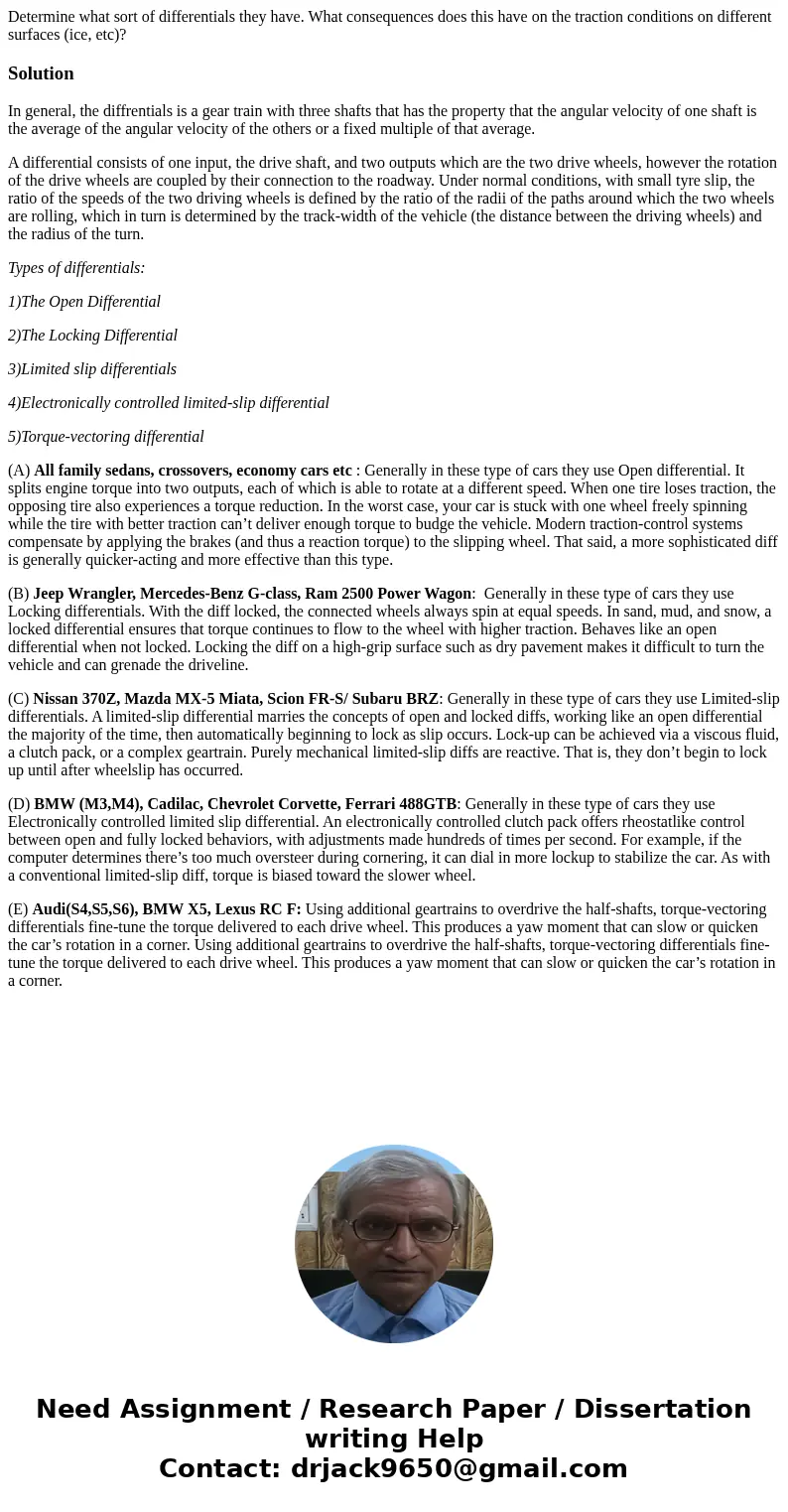Determine what sort of differentials they have What conseque
Solution
In general, the diffrentials is a gear train with three shafts that has the property that the angular velocity of one shaft is the average of the angular velocity of the others or a fixed multiple of that average.
A differential consists of one input, the drive shaft, and two outputs which are the two drive wheels, however the rotation of the drive wheels are coupled by their connection to the roadway. Under normal conditions, with small tyre slip, the ratio of the speeds of the two driving wheels is defined by the ratio of the radii of the paths around which the two wheels are rolling, which in turn is determined by the track-width of the vehicle (the distance between the driving wheels) and the radius of the turn.
Types of differentials:
1)The Open Differential
2)The Locking Differential
3)Limited slip differentials
4)Electronically controlled limited-slip differential
5)Torque-vectoring differential
(A) All family sedans, crossovers, economy cars etc : Generally in these type of cars they use Open differential. It splits engine torque into two outputs, each of which is able to rotate at a different speed. When one tire loses traction, the opposing tire also experiences a torque reduction. In the worst case, your car is stuck with one wheel freely spinning while the tire with better traction can’t deliver enough torque to budge the vehicle. Modern traction-control systems compensate by applying the brakes (and thus a reaction torque) to the slipping wheel. That said, a more sophisticated diff is generally quicker-acting and more effective than this type.
(B) Jeep Wrangler, Mercedes-Benz G-class, Ram 2500 Power Wagon: Generally in these type of cars they use Locking differentials. With the diff locked, the connected wheels always spin at equal speeds. In sand, mud, and snow, a locked differential ensures that torque continues to flow to the wheel with higher traction. Behaves like an open differential when not locked. Locking the diff on a high-grip surface such as dry pavement makes it difficult to turn the vehicle and can grenade the driveline.
(C) Nissan 370Z, Mazda MX-5 Miata, Scion FR-S/ Subaru BRZ: Generally in these type of cars they use Limited-slip differentials. A limited-slip differential marries the concepts of open and locked diffs, working like an open differential the majority of the time, then automatically beginning to lock as slip occurs. Lock-up can be achieved via a viscous fluid, a clutch pack, or a complex geartrain. Purely mechanical limited-slip diffs are reactive. That is, they don’t begin to lock up until after wheelslip has occurred.
(D) BMW (M3,M4), Cadilac, Chevrolet Corvette, Ferrari 488GTB: Generally in these type of cars they use Electronically controlled limited slip differential. An electronically controlled clutch pack offers rheostatlike control between open and fully locked behaviors, with adjustments made hundreds of times per second. For example, if the computer determines there’s too much oversteer during cornering, it can dial in more lockup to stabilize the car. As with a conventional limited-slip diff, torque is biased toward the slower wheel.
(E) Audi(S4,S5,S6), BMW X5, Lexus RC F: Using additional geartrains to overdrive the half-shafts, torque-vectoring differentials fine-tune the torque delivered to each drive wheel. This produces a yaw moment that can slow or quicken the car’s rotation in a corner. Using additional geartrains to overdrive the half-shafts, torque-vectoring differentials fine-tune the torque delivered to each drive wheel. This produces a yaw moment that can slow or quicken the car’s rotation in a corner.

 Homework Sourse
Homework Sourse